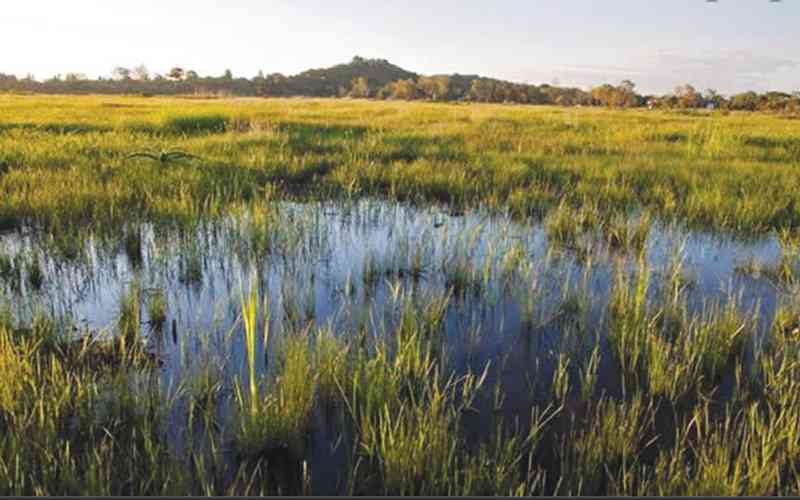
There is growing concern over the invasion and destruction of wetlands and wildlife by human activities such as farming and construction in Zimbabwe, we can report. A wetland is a low-lying marshy area and forms headwaters for rivers.
They act as natural water reservoirs. Most of the wetlands are home to hundreds of birds, some of which are endangered. They also shelter mammals and provide water for wildlife.
The country’s biggest protected wetland in Harare, the Monavale Vlei is also under threat. Wetlands are an important component of Zimbabwe’s environment. The commitment is demonstrated by Zimbabwe being a party to the Ramsar Convention on Wetlands of 1971.
The convention provides the framework for national action and international co-operation for the conservation and wise use of wetlands and their resources. Wetlands of International Importance included among 2 266 Ramsar Sites cover over 2,1 million square kilometres globally.
Designated Ramsar protected wetlands sites in Zimbabwe include Victoria Falls, Driefontein Grasslands, Middle Zambezi/Mana Pools National Park, Lake Chivero Recreational Park, Monavale Vlei (Harare), Chinhoyi Caves, Cleveland Dam.
Victoria Falls wetlands are located in an area which is currently at the centre of a legal dispute. Companies planning to build on restricted zones marked by Unesco as World Heritage sites have been dragged to court by local environmentalists contesting their permits to go ahead with construction. The area under dispute includes wetlands in the rainforest area and in the precincts of the area.
In February 2022, officials from Unesco warned that Victoria Falls was facing threats from individual and cumulative infrastructure developments. They suggested the halting of activities to preserve the resort city’s world heritage status. On May 13, Lawrence Norton and other applicants approached the courts suing two private companies, ZimParks and a regulatory agency, Procurement Regulatory Authority of Zimbabwe (Praz).
“The purpose of this application is to prevent the development of commercial interest at the cataract and rainforest sites, which development would only suit the commercial operators,” part of the application read.
- Feature: Human activity threatens Zimbabwe’s wetlands
- Towards ecological stylistics, a new dimension in language and the environment
- Zimbabwe’s climate action: Progress and challenges
Keep Reading
Speaking to Community Podium, Michael Gomo, an environmentalist said wetlands are important in recharging the water table. “They help in naturally filtering and purifying the water, preventing erosion, siltation and flooding.
These sites must be kept intact as they act as carbon sinks, resupply rivers and streams, and save many wildlife species. Wetlands have been controlling pests acting as important sites for biodiversity.
These sites are important for primary products such as agriculture, fisheries and forestry. Many coastal and inland wetlands are popular for tourism and recreational activities such as swimming, boating, fishing, camping and bird-watching, especially Victoria Falls in Zimbabwe and Okavango Delta in Botswana,” said Gomo.
In Harare, the most popular and biggest wetland, Monavale Vlei is under threat due to construction of buildings, and agriculture. Residents groups namely the Harare Wetlands Trust and Monavale Vlei Trust are lobbying against the destruction of the wetlands. Birdlife of Zimbabwe CEO, Julia Pierene said wetlands were under threat, not from natural causes but from human activities; “ These include agricultural activities, commercial and residential development, road construction, resource extraction, and illegal waste disposal which is pollution.”
Animal species recorded at the Victoria Falls Ramsar site wetlands, mostly roaming the Victoria Falls National Park include a number of elephants, buffalo, lions, leopards and black rhinoceros Diceros bicornis, of which 10% of the world population lives in the park. The site also supports a wealth of reptiles, amphibians and over 500 bird species including falcons, eagles, black storks and herons which feed and nest in the area.
The Monavale Vlei supports 36 species of grass and more than 80 other plants with trillions of kilometres of invisible roots which remove toxic chemicals and hold the spongy clay together.
The vlei is home to over 240 bird species, among them small rare migrants which breed in the pools, especially the striped crake and streaky breasted flufftail. Bush pig, cape clawless otter, large grey mongoose, common duiker, giant rat and scrub hare are other animals found on the wetland. Also living in puddles and pools are seven amphibians including the giant bullfrog which is regionally endangered.
The Ramsar Convention advocates for the conservation and wise use of all wetlands through local, regional and national actions and international co-operation, as a contribution towards achieving sustainable development throughout the world. Residents, both in Victoria Falls and Harare say they have a role to play in wetlands and wildlife conservation.
“Land barons who are connected to council officials are the biggest threat to the survival of wetlands and their operations are not sustainable. They are a threat to the survival of a host of wildlife species habitat at wetlands. We continue advocating for the preservation of wetlands,” said Mpumelelo Mpofu, a resident of Victoria Falls.










